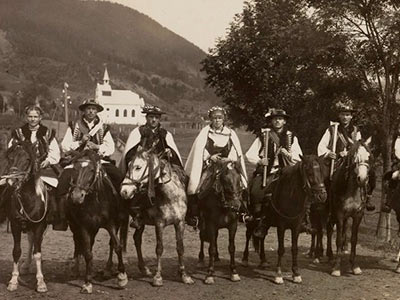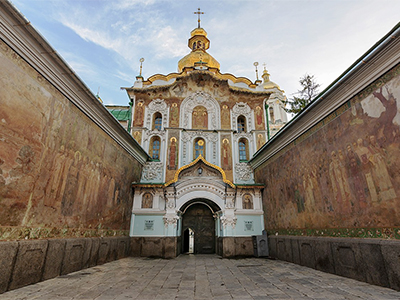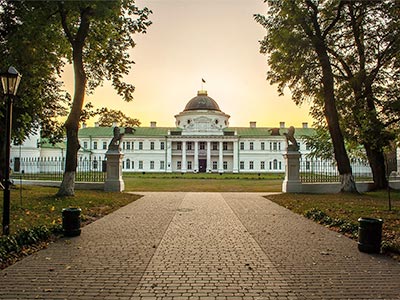 05.01.2024
Hutsuls: passionate and Freedom-Loving
05.01.2024
Hutsuls: passionate and Freedom-Loving“They are Ukrainians, but a bit on the wild side.” That is what their neighbors say about the Hutsuls and their ethnic roots. In spite of considerable differences in traditions, accent and way of life from the rest of the Ukrainians, the Hutsuls have become a symbol and oberih (the ones who maintain the traditions and culture of the Ukrainian nation and protect it from assimilation of the Ukrainian nation, similar in status to that of the Cossacks of old. The Cossacks are history now (attempts to revive Cossack traditions and lifestyle are limited in scope to small groups and individuals], but the Hutsuls are very much part of the present-day Ukrainian scene. Velyka Ukrayina (Great Ukraine], as the Hutsuls refer to the rest of Ukraine, increasingly comes to be culturally represented by the Land of Hutsulshchyna in Western Ukraine.
Hutsuls: the name
There is no consensus as to the origin of the word Hulsul. Originally, the people who are now known as Hutsuls called themselves Irslens. Some ethnographers — and they are in a minority — claim that the Hutsuls formed into a separate ethnic group as a result of several ethnic groups mixing together, with Ukrainians, Rumanians, Polovtsi, Pecheneh and other nomads and ethnics contributing their shares. Other ethnographers and historians — and they are in a majority — argue that the Hutsuls are basically of Ukrainian descent with an admixture of some other bloods who, because of their relative isolation in the mountains, have developed their traditions and culture which distinguish them from Ukrainians in other parts of Ukraine. Hutsuls speak Ukrainian, though with an easily identifiable accent; there are many words in their speech which can be regarded as specifically Hutsul. Their way of life, volatile temperament, customs, habits, traditions, dress and food bear distinctive Hutsul traits — and yet, unbiased observations reveal the basic, underlying features which are common to all the Ukrainians.
There is a theory that says that every nation or an ethnic group has o potential for active development which is called “passionateness”. This passionateness manifests itself in various ways at various stages of the nation’s or ethnic group’s development. It may find a violent release — then such a nation or ethnic group becomes aggressive and tries to conquer others. It may have an artistic or whatever other release it may happen to be. In Ukraine, this theory can be applied to the Cossacks in the south and to the Hutsuls in the west of Ukraine. It is a nice theory but it hardly explains anything.
The Hutsuls are freedom-loving people. They never allowed any ruler to turn them into slaves or serfs. Compared to the rather docile Ukrainians of the central parts of Ukraine, the Hutsuls may seem passionate, or even violent.
There are various theories that seek to explain the origin of the name Hutsul. According to one of such theories, the Volokhs, the Hutsul neighbors in the times of old (now they are better known as Moldavians and Rumanians), used to call their restless neighbors Hots, that is bandits. It is true that there were many “Robin Hoods” among the Hutsuls. Oleksa Dovbush being the most famous — or notorious, depending on how you look at it — among them. They robbed the rich (foreigners who were the oppressors) to give the loot to the poor, but most of the Hutsuls minded their own business and just wanted to be left alone.
The first written mention of Hutsuls has been discovered in a Polish document that dates to 1754. The document says that a Hutsul woman was accused of setting fire to a landowner’s house and found guilty of arson, for which crime she was sentenced to death and executed.
Another theory of the origin of the word Hutsul worth mentioning links to the Turkish word “hutsul” that means “a horse,” but not any kind of horse but the one that got adjusted to life in the mountains. It is one of the sturdiest horses in the world, small in stature, not very handsome but tireless and requiring little to eat. It was an ideal horse for the Carpathians with their severe conditions. It not only survived the rigors of the climate but helped the people to survive. It was thanks to these horses that Irsten settlements which started to be established in the valleys, gradually moved up the slopes, climbing higher and higher. And also, it is thanks to these “hutsul” horses that Irstens got a new name — Hutsuls.
Still another theory says that the word “Hutsul” is a derivative of the word “kuchul”, which means “a nomad”. Irsten men made seasonal “migrations” — with the advent of spring they drove the sheep and cattle up the mountains to the alpine meadows with their luxuriant grasses, and when the colder autumnal days came, they returned to the valleys, back to their homes and families. In fact, not much has changed since the times of old — Hutsul men still do the same now as they did hundreds of years ago.
The Volokhy (Rumanians of the Carpathians) and the Hutsuls live as peaceful neighbors, now separated by the border but sharing a lot of cultural traditions. Rumanian horses and cows freely walk across the state border into Ukraine to graze; and after getting their fill, they go back home. Both Rumanian and Hutsul shepherds know for sure that stray horses and; cattle will always return safely home.
Hutsuls: a bit of history
By the virtue of their natural conditions, the Carpathian mountains were a place to which the oppressed and persecuted fled seeking and finding refuge there. It all began back In the Roman limes, when Dacia (now Rumania) was a Roman province.
The old name for the area where the Hutsuls live is Halicia, or Galicia, which may suggest that at some lime in the past it could have been Inhabited by the Celts must have been later supplanted by the Slavs who, nevertheless, have retained a number of place names and words which can be supposedly traced back to the Celtic roots.
A less bold and much more accepted theory suggests that some time in the first millennium BCE, a Slavic tribe of Ruthenians migrated from elsewhere to the area now occupied by the Hutsuls and settled down, gradually developing into an ethnic group, the Hutsuls of today.
Ethnographic studies of the Hutsuls began at the end of the eighteenth century and continued in the nineteenth, culminating in a monumental work, Hutsulshchyna, by V. Shukhevych published in 1899— 1908 in eight volumes. A number of Ukrainian writers, Ivan Franko and Mykhailo Kotsyubynsky among them, described the Hutsul life in fiction. Kotsyubynsky’s novel, Shadows of Our Forgotten Ancestors, was even made into a very successful film by the director Serhiy Paradzhanov in the nineteen-sixties.
Over the centuries, the Land of Hutsulshchyna (‘Galicia’) changed hands; from the end of the eighteenth century and up to 1918 it was under the domination of the sprang up in part of Hutsulshchyna. The Hutsul Republic with the center in the town of Yasynya existed from November 1918 to June 1919. It was included into Ukraine only in 1939.
Hutsuls: way of life
The Hutsuls, living in relative isolation from European civilization and from the rest of ‘Great Ukraine’ developed, as we have already mentioned, a way of life distinctly their own. Life in the mountains breed stamina, endurance and skills necessary for survival. Strangers and outcasts find it extremely difficult, or actually impossible, to get adjusted to or be accepted by the Hutsul community. On the other hand, the Carpathian mountains in Hutsulshchyna are of such an overwhelming beauty that those who are born there find it extremely hard to leave the native land or change their way of life.
Summers are the time of hard work — tilling the land and taking care of the sheep, cattle, horses and other domestic animals. But the surrounding natural beauty helps to make hard life more endurable. Winters are the time when holidays and feasts can be celebrated with abandon, when new dresses can be made, when needlework can be done, rushnyky (decorative towels) embroidered, when pysanky can be painted, when stories and fairy tales can be told, when wood can be carved, and many other useful and useless things can be done. It has been going like this, with little changes, in the Land of the Hutsuls for centuries.
If you are a traveler, you will be accorded a warm welcome. You will be dined and wined, you will be told stories, true and tall, and nobody will ask who you are and where you are from; they will wait until you tell your story yourself. But this hospitality will turn into hostility if you make an attempt to become part of their life — the Hutsul community rejects strangers. And you cannot do anything about it.
If generalizations are possible, then we can say the Hutsul men are tall, with Roman noses, black hair, not unlike that of horses’ tails, dark — sometimes blue — eyes, long legs, long arms and long hands with long fingers. Women are mostly of short stature; slim, full of pep, vivacious and beautiful. They talk fast, they do things fast, they are clever with their hands. And they are always dressed in great taste, in a remarkable, traditional Hutsul way.
In general, the Hutsuls like to be dressed well, and take great pains with their attire. Men like bright decorations on their clothes. In the olden days, when clothes were very expensive, they were passed from generation to generation (not everyday clothes of course — we are talking of Sunday clothes). There were even murders committed over dresses.
Hutsul men used to carry weapons with them, pistols and axes on long handles. If a Hutsul had only two pistols stock into his bell, he was considered to be poor. Hutsul men have retained their love of weapons but they do not exhibit if so openly.
Hutsuls like to be showing off. When they take a walk, they want others to see how well they are dressed; when they dance, they do their best to show that they dance well; when they work, they want others to see how well they can work.
Some of the Hutsul houses seem to be kept primarily for the guests, with the interiors decorated with embroidered rushnyky, carpels, and wood carving. Such Hutsuls live in a little house in the backyard which they call litnya kukhnya, summer kitchen.
Hutsuls are freedom-loving and independent people, full of dignity. Sometimes better suited for life and conditions in the mountains than jeans. Cars are no good in the mountains either — Hutsul horses are a much more reliable means of transportation in the forests with no roads and high in the mountain slopes. Winters will never become summers and long winter nights will continue to be filled with embroidery, painting pysanky, handicrafts and music, even though some of the instruments will surely be more sophisticated than they used to be. Summers will require much work on the available land and shepherding in the mountains. Tourism is not likely “to spoil” Hutsuls either — it gives Hutsuls another chance to show off before the visiting tourists. Hutsul applied and decorative art is in demand — many of the Hutsul works of decorative art have found their way to private and public collections in many countries of the world.
Hutsuls also remember well that the geographical center of Europe is situated in their land, in the town of Rakhiv, and being right in the center of Europe, they are not in a hurry to leave their mountains.
-
 27.02.2024
World of pysanka
Embark on a journey into the captivating world of Pysanka, the Ukrainian...
27.02.2024
World of pysanka
Embark on a journey into the captivating world of Pysanka, the Ukrainian...
-
 29.01.2024
Exploring the Treasures of Kyiv’s Lavra Monastery
In the heart of Kyiv lies the venerable Lavra Monastery, a testament...
29.01.2024
Exploring the Treasures of Kyiv’s Lavra Monastery
In the heart of Kyiv lies the venerable Lavra Monastery, a testament...
-
 13.01.2024
Kachanivka, Eden on Earth
Rich in history, it hosted renowned artists, notably poet Taras Shevchenko.
13.01.2024
Kachanivka, Eden on Earth
Rich in history, it hosted renowned artists, notably poet Taras Shevchenko.

